GEYSERS AND FUMAROLES
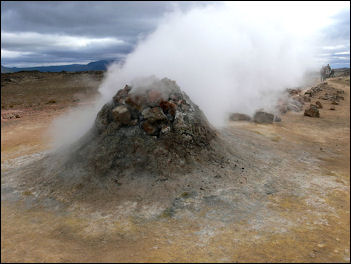
Fumarole Namafjall in Iceland Geysers, fumaroles (also called solfataras), and hot springs are generally found in regions of young volcanic activity. Surface water percolates downward through the rocks below the Earth's surface to high-temperature regions surrounding a magma reservoir, either active or recently solidified but still hot. There the water is heated, becomes less dense, and rises back to the surface along fissures and cracks. Sometimes these features are called "dying volcanoes" because they seem to represent the last stage of volcanic activity as the magma, at depth, cools and hardens.
Fumaroles, which emit mixtures of steam and other gases, are fed by conduits that pass through the water table before reaching the surface of the ground. Hydrogen sulfide (H2S), one of the typical gases issuing from fumaroles, readily oxidizes to sulfuric acid and native sulfur. This accounts for the intense chemical activity and brightly colored rocks in many thermal areas.
Hot Springs

Doublet Pool in Yellowstone Hot springs occur in many thermal areas where the surface of the Earth intersects the water table. The temperature and rate of discharge of hot springs depend on factors such as the rate at which water circulates through the system of underground channelways, the amount of heat supplied at depth, and the extent of dilution of the heated water by cool ground water near the surface.
Hot springs are produced by water that is heated underground and pushed to the surface of the Earth, often by pressure created as bubbles in the water expand. In some cases the water flows to surface with a regular flow and forms pools. Many commercial hot springs are not true hot springs in that they tap hot water sources deep in the Earth and pump the water to the surface.
The source of hot spring can be rain water, groundwater or water that has bubbled up from deep in the Earth. The latter has been heated by lava chambers and forced upward through cracks in the rocks.
Sometimes colonies of bacteria and blue-green algae flourish in pools of scalding hot spring water on the surface. Sometimes a rainbow of different colors is formed by layers of different kinds of colored bacteria and algae that survive in specific temperature ranges.
Geysers
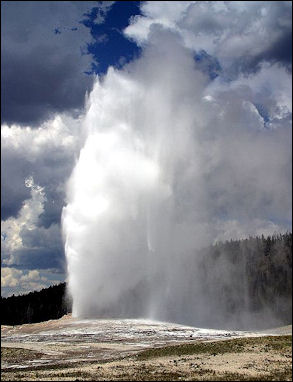
Old Faithfull Erupting geysers provide spectacular displays of underground energy suddenly unleashed, but their mechanisms are not completely understood. Large amounts of hot water are presumed to fill underground cavities. The water, upon further heating, is violently ejected when a portion of it suddenly flashes into steam. This cycle can be repeated with remarkable regularity, as for example, at Old Faithful Geyser in Yellowstone National Park, which erupts on an average of about once every 65 minutes.
Geysers are hot springs with a particular geometry that act as conduits for spasmodic burst of hot water. The classic ones produce intermittent explosive eruptions of steam and hot water that occur at regular intervals. The word geyser comes from the Icelandic word “geysa“ , which means "to rush forth furiously."
Geysers occur in volcanic basins where porous, fissured rock layers contain water under pressure and magma is close enough to the surface to heat this water. In places where there is a wide, unobstructed passage a hot spring is formed. In places where the passage is narrow and there is a hole for the water to escape geysers sometimes form.
In geyser basins water accumulates in small subterranean chambers and seeps towards the magma zone, were it is superheated under pressure. As the water is forced back towards the surface, the pressure is relieved and the volume expands, until it finally flashes into steam and a columns of water that surge from the surface as erupting geysers.
A geyser forms where water collects in a tube but doesn't boil immediately because of pressure caused by water in the upper reaches of the tube raises the boiling point. The temperature of the water at about 300 feet down can be over 400̊F. When the water finally does reach its boiling point some of it vaporizes which causes the remaining water to first bubble out of the tube and then explode violently as the pressure from vaporization is released. After the water is expelled, more ground water fills up the tube and the process begins all over again.
Geothermal Energy in Japan
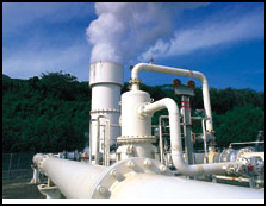
Geothermal Energy in Japan There are 18 geothermal power plants in Japan, and together they account for only 0.3 percent of Japan’s electricity production. Geothermal facilities in Japan are capable of generating up to 530,000 kilowatts of power. They are found mainly in the Kyushu and Tohuku regions. Most of the plants were built before the mid 1980s.
The geothermal power plants on the island of Kyushu harness steam to turn electricity-producing turbines. The first one opened in 1924 in Bepphu, where steam is also used to heat houses and cook food in restaurants. Natural heat is also used in sulfur extraction plants and eel and alligator farms.
Japan may have a geothermal generation potential of much as 20 million kilowatts, enough to make up 10 percent of Japan’s power generation capacity.
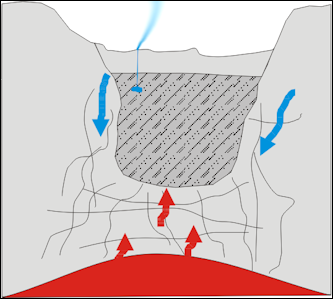
heat for a geyser Most geothermal plants tap into hot underground water sources. More than half the thermal sources are located around national parks and/ or near the country’s 27,000 thermal springs that onsens (hot spring resorts) rely on for their hot water supplies. Restrictions on drilling and development costs raise the costs to around ¥16 for a kilowatt per hour — three times the cost of thermal or nuclear power.
With conventional geothermal power generation, vapor reaching 200 degrees C is pumped from deep underground to a power-generating turbine. Japan is now studying binary systems in which liquids with lower boiling points than water’such as ammonia or pentane, which has a boiling point of only 36 degrees C are sent to a heat exchanger within which they are transformed to vapor using hot water. The vapor is then directed to a turbine for power generation. In this way power can be generated with sources whose temperatures are as low as 100 degrees C. A binary geothermal plant in Kokonoemahci, Oita Prefecture has an output of 2,000 kilowatts,
Describing the Yanaizu-Nishiyama geothermal plant in Fukushima Prefecture, Andrew Pollack wrote in the New York Times: “Some 300 tons of steam and hot water emerge every hour here from 21 wells drilled as deep as one-and-a-half miles. The steam is sent through a maze of pipes to a nearby power plant run by the regional utility, to turn an electrical turbine. There is virtually no sound to indicate all the steam whooshing around. And the power plant is simple enough that it can be controlled remotely from hundreds of miles away.” [Source: Andrew Pollack, New York Times, May 9, 2011]
Geothermal energy is not without risks. In October 2010, one man was killed and one was injured when hot water gushed out of a hole at a geothermal plant near Sendai in Miyagi Prefecture. The 63-year-old dead man was found buried under sand and dirt that gushed out with the water. Police said he was using a power shovel to plug a hole made by a similar gusher a week or so earlier. The 48-year-old injured man suffered extensive burns.
Japan Doesn’t Get as Much Electricity from Geothermal Energy as It Could
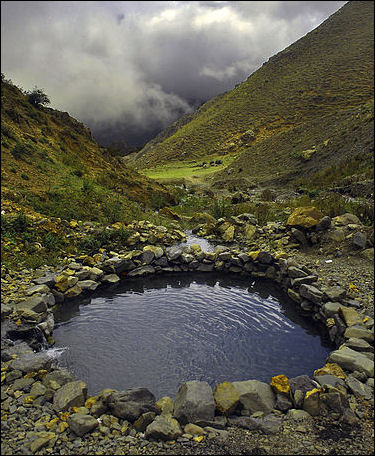
Hot spring Andrew Pollack wrote in the New York Times: “As visitors to any of Japan’s thousands of hot springs know, this country is sitting on a lot of very hot water. So far, though, little of it has been harnessed to produce energy...But some say that with Japan’s reliance on nuclear power plants coming into question, the country should harness more of its geothermal natural resource to provide clean, renewable energy.” [Source: Andrew Pollack, New York Times, May 9, 2011]
“Japan has 10 percent of the world’s volcanic activity, so I think there is the possibility for more development,” said Kengo Aoyama, engineering section chief of the Yanaizu-Nishiyama geothermal plant, located here in an area filled with hot spring resorts. Yanaizu-Nishiyama is located in Fukushima Prefecture not too far from nuclear power plant with rectors that melted down after the earthquake and tsunami in 201.
The Washington-based Earth Policy Institute argues that geothermal energy could provide as much as 80,000 megawatts of capacity in Japan “ compared with only 535 megawatts now “ and become a mainstay of its power production. Advocates in Japan are more cautious. Sachio Ehara, an expert at Kyushu University, said the potential for geothermal energy was around 23,000 megawatts, although new technology could increase it. Geothermal could supply 10 to 20 percent of Japan’s electricity by 2050, he said.
Obstacles to Developing Geothermal Energy
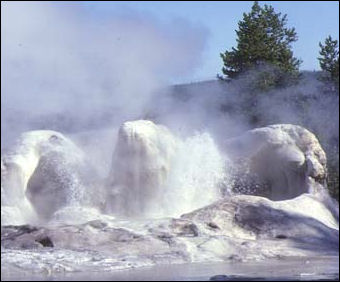
Yellowstone geyser The obstacles to developing geothermal energy include operators of hot springs resorts, who worry that geothermal projects will sap their hot water supplies, and the fact that many of the best hot water reservoirs are in national parks and therefore off limits to development. Unlike solar or wind energy, geothermal power cannot be developed quickly because it takes years to explore and develop a field “ a process analogous to prospecting for oil. [Source: Andrew Pollack, New York Times, May 9, 2011]
And largely because of drilling expenses, a geothermal power station costs about three times as much to build as a coal-fired plant of similar capacity, Masaho Adachi, president of the Okuaizu Geothermal Company, told the New York Times. But he said that high upfront cost is offset over time, because geothermal plants do not burn fuel. Nonetheless, Okuaizu, a subsidiary of Mitsui Mining and Smelting, is losing money on the Yanaizu-Nishiyama plant. But Mr. Adachi said the geothermal business would become more viable if the Parliament, as expected, enacted a law to require electric companies to buy geothermal energy at a premium price. [Ibid]
Geothermal power, while considered clean energy, is not always perfectly renewable because a hot water field can be tapped more quickly than it can be renewed. The Yanaizu-Nishiyama plant, which opened in 1995, is rated at 65 megawatts of capacity, but production has fallen to only half that level. And there is a fear that the drilling, or the practice of injecting cool water back into the ground, could induce earthquakes. But at least Mr. Aoyama does not have to worry about a release of deadly radiation like that from the Fukushima Daiichi nuclear plant, 75 miles east of here. His main environmental concern is the rotten-egg smell of hydrogen sulfide, which can be harmful in high concentrations but not in the amounts likely to escape from the geothermal plant. “It smells a little,” Mr. Aoyama told the New York Times, “but not so much that the neighbors complain.” [Ibid]
See Iceland, Italy.
Image Sources: Wikimedia Commons, United States Geological Survey (USGS)
Text Sources: United States Geological Survey (USGS), New York Times, Washington Post, Los Angeles Times, Times of London, Yomiuri Shimbun, The Guardian, National Geographic, The New Yorker, Time, Newsweek, Reuters, AP, Lonely Planet Guides, Compton’s Encyclopedia and various books and other publications.
Last updated January 2012
